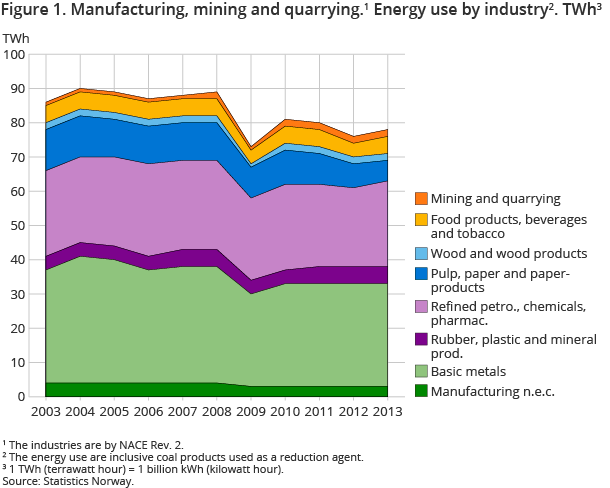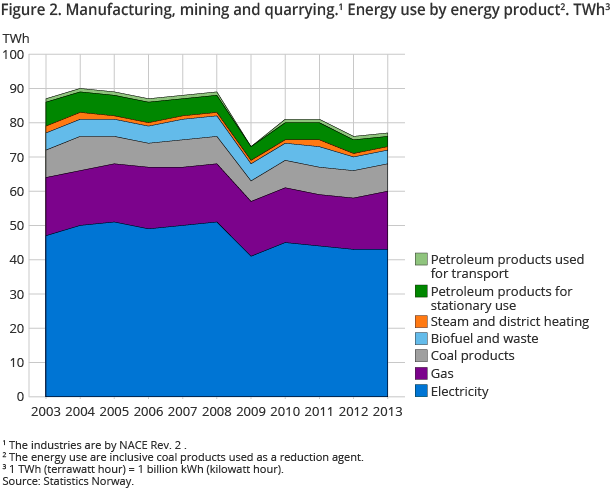Content
Published:
This is an archived release.
Increased energy use in manufacturing
Total energy use in manufacturing, mining and quarrying amounted to 78 011 GWh in 2013. The preliminary figures show an increase of 2.5 per cent compared to 2012. Total energy costs amounted to NOK 20.3 billion; an increase of 3.6 per cent.
| Total energy consumption | Energy costs | |||
|---|---|---|---|---|
| Gwh | Per cent | NOK million | Per cent | |
| 20132 | 2012 - 2013 | 20132 | 2012 - 2013 | |
| 1Published data are based on SN07. | ||||
| 2Preliminary figures | ||||
| 05,07,08,09.9,10-33 Manufacturing, mining and quarrying | 78 011 | 2.5 | 20 315 | 3.6 |
| 05,07,08,09.9 Mining and quarrying | 1 780 | 10.8 | 1 090 | 17.6 |
| 10-33 Manufacture | 76 230 | 2.3 | 19 226 | 2.9 |
| 10-12 Manufacture of food products and beverages | 4 665 | 4.3 | 2 465 | 7.8 |
| 16 Wood and wood products | 1 773 | -3.6 | 481 | -4.2 |
| 17 Paper and paper products | 6 097 | -14.4 | 1 226 | -11.1 |
| 19-21 Refined petro., chemicals, pharmac. | 24 953 | 8.1 | 4 228 | -0.1 |
| 22-23 Rubber, plastic and mineral prod. | 4 984 | 6.5 | 1 732 | 14.6 |
| 24 Basic metals | 30 398 | 1.3 | 7 196 | 3.5 |
| 13-15,18,25-33 Manufacturing n.e.c. | 3 360 | 1.6 | 1 898 | 3.9 |


The consumption of gas increased by 15 per cent from 2012 to 2013, and accounted for 22 per cent of the total energy use. Electricity is the most important energy product in the Norwegian manufacturing, mining and quarrying sector, with 55 per cent of the total energy use, but the consumption was nearly unchanged from 2012 to 2013. The consumption of coal products increased by 1.3 per cent, while the consumption of biofuels and stationary petroleum products dropped by 7.5 and 0.2 per cent respectively.
Increase in oil refineries, chemical and pharmaceutical industries
The biggest increase in energy consumption can be seen in the oil refining, chemical and pharmaceutical industries. Energy use amounted to 24 953 GWh in 2013; an increase of 8 per cent from 2012. The consumption of gas alone increased by 17 per cent to 13 372 GWh. The gas price in these industries decreased by 9 per cent to 27.3 øre/kWh excluding VAT, while the gas price for all manufacturing industries decreased by 3 per cent to 36.8 øre/kWh.
Minor changes in power intensive industries
The power intensive industries account for around 80 per cent of the total power consumption and around 70 per cent of total energy consumption in manufacturing. The total energy consumption amounted to 51 825 GWh and the electricity consumption amounted to 34 377 GWh in 2013, virtually unchanged from 2012.
However, there are some differences within the power intensive industries. The energy consumption in the manufacture of pulp and paper amounted to 6 011 GWh; a decrease of 13.5 per cent from 2012.This is mainly due to closures. The energy consumption in basic chemical industries amounted to 15 590 GWh; an increase of 1.3 per cent. The manufacturers of basic iron, steel and of ferro-alloys had an increase in energy consumption of 2.4 per cent to 10 324 GWh, while the energy consumption for the manufacturers of basic precious and non-ferrous metals was nearly unchanged at 19 900 GWh in 2013.
The electricity price for manufacturers of pulp and paper increased by 7.9 per cent to 31.4 øre/ kWh, and for the manufacturers of basic chemicals the price increased by 1.5 per cent to 34.5 øre/ kWh. The price for the manufacturers of basic metals increased by 8.7 per cent to 27.6 øre/ kWh, while the price for the manufacturers of basic precious and non-ferrous metals increased by 4.3 per cent to 24.5 øre/kWh. The average price for other industries was 51.6 øre/kWh; an increase of 7.2 per cent.
Contact
-
Tove Helene Løvbak
E-mail: tove.lovbak@ssb.no
tel.: (+47) 40 02 08 94
-
Ingunn Ruud
E-mail: ingunn.ruud@ssb.no
tel.: (+47) 48 99 65 63
